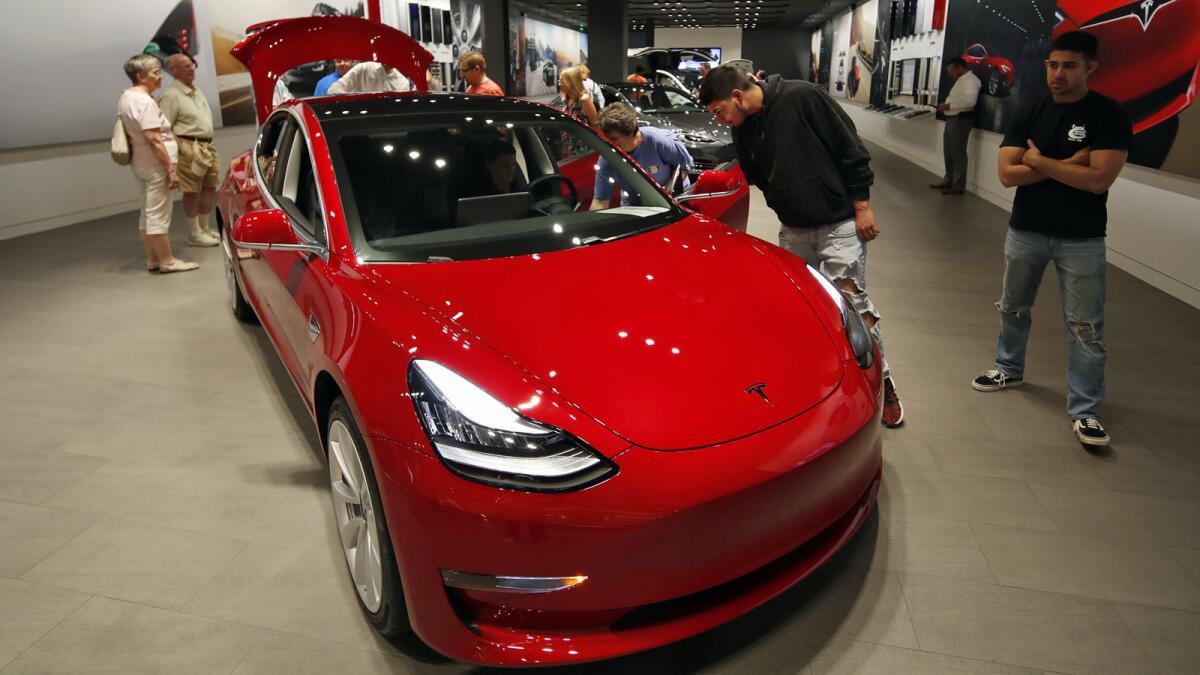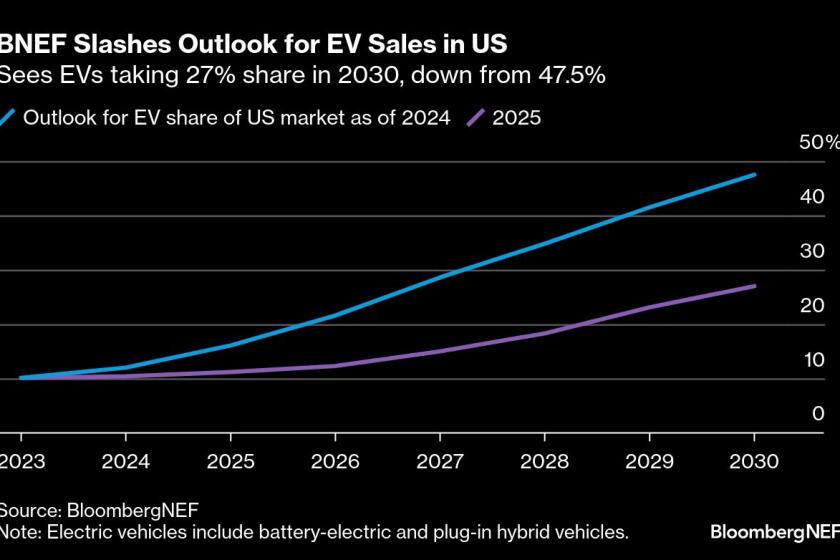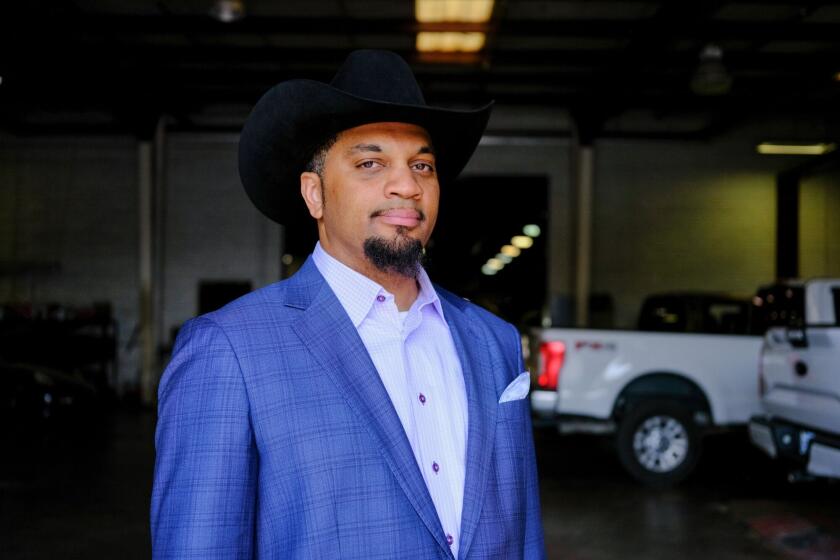A key Tesla supplier cuts growth plans, raising red flags over demand for the Model 3

- Share via
Panasonic is freezing plans to expand its role as Tesla’s electric car battery supplier, a move that raises new questions about demand for Tesla’s Model 3 — and the company’s future.
“The Panasonic news is a gut punch. This fans the flames on overall demand worries and profitability concerns going forward,” said the usually bullish Dan Ives, equity analyst at Wedbush Securities.
Tesla stock fell 2.8% Thursday, to $268.42.
Japan’s Nikkei Asian Review reported Thursday that Panasonic will abandon for now its plans to expand battery cell manufacturing capacity at Tesla’s Nevada battery factory by 54% next year. The previously planned expansion would have increased production from 35 gigawatt hours per year to 54 gigawatt hours.
In a statement, Panasonic said it “established a battery production capacity of 35 GWh in Tesla’s Gigafactory 1 by the end of March in line with growing demand. Watching the demand situation, Panasonic will study additional investments over 35 GWh in collaboration with Tesla.”
A Tesla spokesman said Thursday the company’s demand for batteries remains strong. “Contrary to what is implied in [the Nikkei] report, our demand for cells continues to outpace supply. It remains the fundamental constraint on Tesla vehicle and Powerwall/Powerpack production.” Powerwalls and Powerpacks are home and utility battery storage products assembled and sold by Tesla.
Musk had big plans for the Nevada plant, which he calls a “Gigafactory.” He said in 2017 that four Pentagons could fit inside, and that capacity is likely to exceed 100 gigawatt hours over time.
Each company has set up its own operations at the battery plant. Panasonic makes battery cylinders, which are similar in appearance to a AA battery; Tesla assembles the cylinders into the battery packs that power Model 3 cars.
Because the Model 3 absorbs most of the cylinders Panasonic makes, it would be logical to assume that a cutback in battery production plans translates into a drop of anticipated Model 3 demand.
But a Tesla spokesman said car demand is not a problem. Although the company has put forward several different numbers for production and sales expected this year, it seems to have settled on a production level of 360,000 to 400,000 cars.
Rather than spend cash on battery factory expansion, the spokesman said, “we believe there is far more output to be gained from improving existing production equipment than was previously estimated. We are seeing significant gains from upgrading existing lines to increase output, which allows Tesla and Panasonic to achieve the same output with less spent on new equipment purchases.”
The crowd-sourced, social media swarm that is betting Tesla will crash and burn »
But signs of declining demand are everywhere.
The stock market prices Tesla as a growth company, with a market value of $46.4 billion. But the company reported Model 3 deliveries fell 19%, to 50,900 in the first quarter of this year, and a 56% drop in sales for its Models S and X, higher-priced cars with gross profit margins to match.
If demand for the Model S and Model X doesn’t pick up, the company will produce less than 50,000 this year, half last year’s total.
Meantime, prices for all three cars have been cut, many retail stores and sales centers have closed, and sales employees are being laid off.
“Demand has certainly been curtailed” at Tesla, said Jessica Caldwell, auto industry analyst at Edmunds. “I don’t think they have a waiting list anymore.”
It’s unclear whether Tesla conducted serious demand modeling for its vehicles or whether Chief Executive Elon Musk relied on a “build it and they will come” planning strategy.
The Model 3, available for sale since July 2017, has outsold luxury sedans from the likes of BMW, Audi and Mercedes-Benz. But the sedan market is declining and the high price of luxury car limits total demand.
A cut in federal electric car tax credit subsidies for Tesla cars on Jan. 1 this year — from $7,500 to $3,750, and set to halve again to $1,875 — is bound to have an impact, especially on lower-priced versions of the Model 3.
Caldwell said that while the market for electric vehicles is growing fast, it remains a tiny speck of overall automobile sales. “In terms of market opportunity right now, the EV opportunity is not exactly massive,” she said.
The fact that Tesla is shipping cars to Europe and China is also indicative of demand problems, she said.
“They always pick off the low-hanging fruit when they launch their vehicles,” Caldwell said. “They sell first to employees, then the rest of the U.S. and Canada. If they are selling half their vehicles to Europe and China, it indicates they don’t have as much demand in the U.S.”
Tesla has said that it is temporarily eschewing the U.S. market to serve its customers overseas.
Caldwell pointed to another possible problem: a “low existing buyer base,” meaning that there aren’t that many Tesla owners yet, so trading in for new ones doesn’t add up to much. Customers who buy mass-market vehicles such as Honda Civics and Ford F-150 pickup trucks tend to buy new ones. Tesla’s low base, inevitable for an automobile start-up, “is challenging for demand,” she said.
Tesla last year blamed Panasonic, not customer demand, for a flattening of Model S and X sales. The company said in a quarterly report that S and X sales were “constrained by the supply of cells” from Panasonic. The batteries in those cars are different from those installed in the Model 3.
After The Times reported a slowing of S and X demand in April 2018, a Tesla spokesman called the conclusion “blatantly inaccurate” and noted the battery constraint language. The Times then called Panasonic. The company said “Panasonic has not been requested to increase capacity. In short, Panasonic is supplying cells as planned.”
Twitter: @russ1mitchell







